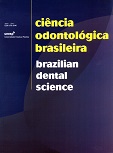Efeito de consecutivas refusões de ligas de Ni-Cr utilizadas em prótese fixa
DOI:
https://doi.org/10.14295/bds.2008.v11i2.463Abstract
Para a confeccao de coroas metaloceramicas, uma serie de etapas devem ser realizadas. A mudanca nesses passos pode ocasionar alteracoes tanto na liga metálica como na porcelana e como consequencia, na adesao entre elas. Um fator que deve ser levado em consideracao, consiste em analisar o efeito das refusões, uma vez que nos laboratorios protéticos torna-se comum a pratica do seu reaproveitamento. Tal fato pode ocasionar perda qualitativa e quantitativa dos elementos de liga e como consequencia, diferenca em suas propriedades, sendo um grande indicativo de falhas em certas coroas. O objetivo deste trabalho foi analisar o efeito do numero de refusoes sobre a microestrutura, porosidade e dureza dessa liga, contribuindo, desta forma, para uma melhoria dos trabalhos proteticos na realizacao das coroas metaloceramicas. Deste modo, coroas de ligas refundidas em 1 e 2 vezes, foram comparadas com aquelas apenas fundidas em dois laboratórios de protese de Natal-RN. As microestruturas foram observadas por microscopia optica. Utilizando-se o programa de analise de imagem, Image Pro-Plus, avaliou-se a porosidade existente nessas amostras. A amostra fundida apresentou regioes com porosidade maxima de 9% no laboratorio 1 e 11% no laboratorio 2, enquanto que as amostras das ligas refundidas e refundidas 2 vezes apresentaram porosidades ate 14% e 86% respectivamente no laboratorio 1 e 12% e 70% no laboratorio 2. Com relacao a microdureza, os resultados indicaram que, na medida em que se aumenta o numero de refusoes, a dureza diminui para ambos os laboratorios.
Downloads
Downloads
Published
How to Cite
Issue
Section
License
Brazilian Dental Science uses the Creative Commons (CC-BY 4.0) license, thus preserving the integrity of articles in an open access environment. The journal allows the author to retain publishing rights without restrictions.
=================




























